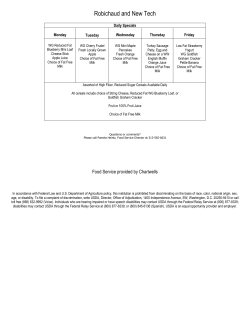
NLAL FAQs - Anova Health
NLAL FAQs Q: How long does the treatment take? A: Twenty (20) minutes in total. LED Laser and exercise are done concurrently to speed up the lymphatic system and muscle in the fat calorie burning process. Q: How are the measurements taken? A: Three separate measurements are taken on the area treated at regular intervals Q: How many calories will be lost in a single treatment? A: A single treatment would mobilize approximately 300-‐500—calories; although tests have proven to be as high as 800 calories Q: What are the advantages of LED over invasive processes? A: There are major advantages against invasive processes; including no pain against severe pain, instant results against up to 16 weeks recovery for liposuction, possible risk of infections with invasive surgery, price advantages, no damage to body including fat cells as opposed to total removal of cells, blood vessels etc., post-‐operative numbness, etc. See link Liposuction vs. NLAL. Q: How is the “fat” reduced beyond the information already provided? A: When energy is required by the body, the brain sends signals to the adipose cells to break down the stored fat, a process called lipolysis. During this process, free fatty acids are released into the bloodstream and circulate throughout the body. Chromophores are part of a molecule which can absorb certain wavelengths of visible light. Specific wavelengths of light cause fat cell membranes to lose their round shape by changing the permeability of the cell. This light creates photobiomodulation within the adipose cells signaling a change inside each adipose cell, creating pores or channels in the cell wall. This alteration of the cell triggers the release of an enzyme (lipase) which can break the triglyceride molecules down into fatty acids and glycerol molecules which are now small enough to pass through the pores of the cell wall releasing stored fat. Exercise is essential to create the demand for energy which can now be met by the released fatty acids and glycerol from the adipose cells, completing the inch loss process. Furthermore, due to release of “stored food” in the fat cells you will not be hungry as you typically are post-‐exercise. Q: In regard to using a body wrap after the NLAL treatment, can this be instead of working out? A: A body wrap is a nice way of improving the hydration/texture of the epidermis and also reduce water retention, but offers no benefit for fat reduction that is demonstrated in any medical research. It certainly cannot be used instead of working out. There is no getting away from it; the patient has to perform cardiovascular exercise to burn calories. There is no other way to eliminate fat from the body. The body will not eliminate fat on its own, and its whole purpose is to store fat. Q: How many treatments can the client have? When should they stop having treatments? How much rest time between courses? A: The standard course is 4-‐16 sessions, 2-‐3 times per week for 8 weeks and 2 optional top up sessions during the following 2 weeks could be undertaken. (There is flexibility to do one per week if that is more suited to the client’s schedule). We do only 2-‐3 treatments a week to allow the blood fatty acid levels to stabilize after each treatment. Further treatments can be undertaken after a 2 week break. This break is also to allow the body to return to its normal mode of action and can help the clinic to ascertain if the client is actually making the changes to their diet and lifestyle that are required to maintain the results NLAL gives them. If they come back after the two weeks having gained it all back, further consultation and advice needs to be given to decide if there is any point to continue treatment. Q: What is the wave length of the LEDS? A: 635nm – scatter & dominant Q: How many paddles does the NLAL have? A: 8 paddles Q: What is the absorption rate of the NLAL? A: The NLAL system has a far higher absorption rate as opposed to laser due to the refraction and strength of the beam, typically LED 70% absorption compared to laser around 30%. This gives a much higher chance of better results in inch loss and fat reduction. Q: Is NLAL safe? A: The LED system is a safe system that will not harm the eyes, although we do recommend glasses are used for facial treatments as the strong light source could cause headaches or migraine if the client is susceptible. (With the laser products you have more safety issues and in most countries regulations restricting how you can sell.) Q: Even if I am in shape, would I benefit from NLAL? A: Yes. Many people who are in shape have specific areas of fat they would like to remove. NLAL is able to target these problems areas very effectively. Q: Will my triglycerides go up if I do a blood test? A: Yes. Triglyceride levels do go up temporarily during treatment which may show up in blood work. Remember, you are breaking down your own body fat.
© Copyright 2025



















